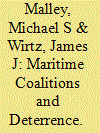| Srl | Item |
| 1 |
ID:
190367


|
|
|
|
|
| Summary/Abstract |
When Bernard Brodie wrote his Guide to Naval Strategy in the early days of the Second World War, he emphasized that US naval operations in the Pacific had to secure bases close to the theater of operations around Japan in order to repair ships, resupply forces, and shift troops to a combat footing after traveling thousands of miles from the West Coast or even Hawaii.Footnote1 Today’s maritime strategists are in a better position when it comes to deterrence in the region. America’s friends and allies across the Indo-Pacific can provide US forces with facilities in peacetime, at the outset of a crisis, or during war.
|
|
|
|
|
|
|
|
|
|
|
|
|
|
|
|
| 2 |
ID:
087043


|
|
|
|
|
| Publication |
2009.
|
| Summary/Abstract |
Indonesia, Thailand, and Vietnam recently announced that they are launching nuclear energy programs, and Malaysia and the Philippines soon may follow suit. As a result, by 2020, at least three states in Southeast Asia could possess latent nuclear capabilities-the option to pursue military applications of dual-use nuclear technology. Analysis of the nuclear programs, domestic proliferation pressures, and the external threat environment in Southeast Asia leads the authors to conclude that the nuclear intentions of states in that region are entirely peaceful and the probability of future nuclear breakout there is low. However, this finding does not justify complacency. In the long term, the benign outlook for regional security may change, and in the near term weak regulatory regimes present serious challenges to nuclear safety and create opportunities that non-state actors may exploit. To minimize these risks, the authors recommend creating a "proliferation firewall" around the region, which would combine strong global support for Southeast Asian nuclear energy programs with innovative regional multilateral nuclear arrangements.
|
|
|
|
|
|
|
|
|
|
|
|
|
|
|
|
| 3 |
ID:
076721


|
|
|
|
|
| Publication |
2006.
|
| Summary/Abstract |
This article reconsiders the conventional wisdom that the prospects for nuclear proliferation in Southeast Asia are too small to mention. After outlining the assumptions that underpin the conventional wisdom, it identifies recent regional and global trends that tend to weaken those assumptions and develops two proliferation scenarios, one centered on Burma and the other on Indonesia. It finds that the prospects for nuclear proliferation in Southeast Asia before 2016 remain nearly as remote as the conventional wisdom suggests, yet current trends suggest that the foundation for future proliferation may be laid during the coming decade. The scenarios suggest that attention ought to be focused not just on countries that are likely to proliferate, but on ways that Southeast Asian individuals might be drawn into regional and global proliferation networks.
|
|
|
|
|
|
|
|
|
|
|
|
|
|
|
|